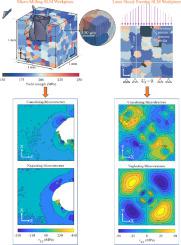International Journal of Engineering Science ( IF 5.7 ) Pub Date : 2021-06-19 , DOI: 10.1016/j.ijengsci.2021.103515 Sumair Sunny , Glenn Gleason , Karl Bailey , Ritin Mathews , Arif Malik

|
This work investigates the significance of microstructure-level modeling by simulating the material response of an inhomogeneous selective laser melted (SLM) Inconel 625 specimen subjected to two different post-process operations, namely micro-milling and laser shock peening (LSP). A physics-based thermal finite element simulation is executed to obtain the SLM thermal history from which a 3-dimensional inhomogeneous microstructure representative volume element (RVE) is generated via the Dynamic Kinetic Monte Carlo predictive model. A Johnson–Cook plasticity definition coupled with Hall–Petch strengthening is used to define unique yield surfaces for individual grains based on their major diameters. Micro-milling and LSP simulations are subsequently executed with and without considering an inhomogeneous microstructure RVE in attempt to elucidate differences in the plastic strain, temperature, induced stress magnitude and distribution, as well as differences that arise during material removal for the micro-milling only. The micro-milling simulations reveal a greater volumetric distribution of plastic strain and temperature for the inhomogeneous case, although the homogeneous case with isotropic assumption reveals greater heat dissipation at the tool-workpiece interface with 27% greater contact pressure and 39% greater frictional shear stress. Examining the ductile and shear damage progression at a specific time increment reveals that the inhomogeneous model has a slightly lower damage propensity in comparison the homogeneous case, despite having identical damage models and boundary conditions. Variation in the SLM process-dependent yield surfaces, for grains at different locations, results in spatial variations of the computed stress triaxiality, which influences the material removal, as well as the stress concentrations developed near the tool-workpiece interface. Thus, a process-structure-property relationship is captured with the microstructure modeling. This work is the first to illuminate the importance of capturing SLM-induced anisotropy, considering the additively manufactured grain structure subject to micro-milling and LSP post-processes.
中文翻译:

显微结构建模对增材制造金属后处理模拟的重要性
这项工作通过模拟非均匀选择性激光熔化 (SLM) Inconel 625 试样经受两种不同的后处理操作,即微铣削和激光冲击强化 (LSP) 的材料响应来研究微观结构级建模的重要性。执行基于物理的热有限元模拟以获得 SLM 热历史,从中通过动态动力学蒙特卡罗预测模型生成 3 维非均匀微观结构代表体积元 (RVE)。Johnson-Cook 塑性定义与 Hall-Petch 强化相结合,用于根据单个晶粒的大直径定义独特的屈服面。随后在考虑和不考虑非均匀微观结构 RVE 的情况下执行微铣削和 LSP 模拟,以试图阐明塑性应变、温度、诱导应力大小和分布的差异,以及仅用于微铣削的材料去除过程中出现的差异. 微铣削模拟揭示了非均匀情况下塑性应变和温度的更大体积分布,尽管具有各向同性假设的均匀情况显示工具-工件界面处的散热更大,接触压力增加 27%,摩擦剪切应力增加 39% . 检查特定时间增量下的延性和剪切损伤进展表明,与均质模型相比,非均质模型具有略低的损伤倾向,尽管具有相同的损伤模型和边界条件。对于不同位置的晶粒,SLM 工艺相关屈服面的变化会导致计算出的应力三轴性的空间变化,这会影响材料去除以及工具-工件界面附近产生的应力集中。因此,通过微观结构建模可以捕获工艺-结构-性能关系。考虑到受微铣削和 LSP 后处理的增材制造晶粒结构,这项工作首次阐明了捕获 SLM 引起的各向异性的重要性。这会影响材料去除,以及工具 - 工件界面附近产生的应力集中。因此,通过微观结构建模可以捕获工艺-结构-性能关系。考虑到受微铣削和 LSP 后处理的增材制造晶粒结构,这项工作首次阐明了捕获 SLM 引起的各向异性的重要性。这会影响材料去除,以及工具 - 工件界面附近产生的应力集中。因此,通过微观结构建模可以捕获工艺-结构-性能关系。考虑到受微铣削和 LSP 后处理的增材制造晶粒结构,这项工作首次阐明了捕获 SLM 引起的各向异性的重要性。









































 京公网安备 11010802027423号
京公网安备 11010802027423号